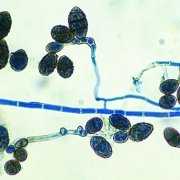Exposure to Mold is a Proven and Serious Health Threat
Vancouver, Canada – Many property owners, landlords, employers, and mold victim relatives in Canada, the USA, and worldwide often question or minimize the proven and serious health threat arising from exposure to elevated levels of indoor mold infestation, according to Phillip Fry, Certified Mold Inspector, Certified Mold Remediator, and author of the book Mold Health Guide.
Mold’s Harmful Effects
“All molds have the potential to cause health effects. Molds can produce allergens that can trigger allergic reactions or even asthma attacks in people allergic to mold. Others are known to produce potent toxins and/or irritants,” according to the US Environmental Protection Agency (EPA).
A number of commonly found mold species are, in fact, toxic mold, a description applied to any mold that produces mycotoxins in its spores. Stachybotrys (black mold), Aspergillus, and Penicillium are three of the most dangerous and commonly found indoor toxic molds.
Mycotoxins are cytotoxic, meaning they have the capacity to pass through the human cellular wall and disrupt certain cellular processes – potentially causing serious health damage to workers and customers.
Studies on animals and cell cultures in labs have found toxic effects from various microbial agents, raising concerns about whether these same agents growing in buildings can cause illness in people, according to the 2004 mold health report from the Institute of Medicine (U.S. Government’s National Academy of Sciences).
Mold Health Symptoms
Fungi can cause health problems to both humans and animals by several different biological mechanisms: infections, allergic or hypersensitivity reactions, irritant reactions, or toxic reactions—reported a 2004 University of Connecticut Health Center report
If exposed to elevated levels of indoor mold, some or many residents and workers can experience one or more of most common, mold health symptoms: allergies, asthma, bleeding lungs, breathing difficulties, cancer, central nervous system problems, recurring colds, chronic coughing, coughing up with blood, dandruff problems (chronic) that do not go away despite use of anti-dandruff shampoos, dermatitis, skin rashes, diarrhea, and/or eye and vision problems, fatigue (chronic, excessive, or continued) and/or general malaise, flu symptoms (chronic), sudden hair loss, headaches, hemorrhagic pneumonitis, hives, hypersensitivity pneumonitis, irritability, itching (of the nose, mouth, eyes, throat, skin or any other area), kidney failure, learning difficulties or mental dysfunction or personality changes, memory loss or memory difficulties; and/or open skin sores and lacerations, peripheral nervous system effects, redness of the sclera (white of your eyes), runny nose (rhinitis) or thick, green slime coming out of nose (from sinus cavities), seizures, sinus congestion, sinus problems, and chronic sinusitis, skin redness, sleep disorders, sneezing fits, sore throat, tremors (shaking), verbal dysfunction (trouble in speaking), vertigo (feelings of dizziness, lightheadedness, faintness and unsteadiness), and vomiting.
Mold Health Studies
“Where is the proof?” ask skeptical moldy home sellers, landlords, employers, and unaffected relatives of mold victims. There is actually abundant evidence about the serious impact of mycotoxins and mold exposure in human disease.
Medical studies in both the military and agricultural environments have discovered that that significant health problems can readily arise from the inhalation of elevated levels of fungal spores and toxins by soldiers and farmers. Laboratory studies in animals and at the cellular level provide supporting evidence for direct toxicity of fungal spores and mycotoxins in mammalian lungs (University of Connecticut Health Center report in 2004).
As to asthma (one of the most common health consequences of mold exposure), a health study by the Finnish Institute of Occupational Health links adult-onset asthma to workplace mold exposure—“The present (health study) results estimated that the percentage of adult-onset asthma attributable to workplace mold exposure to indoor molds and development of asthma in adulthood. Our findings suggest that indoor mold problems constitute an important occupational health hazard.”
The Finnish workplace mold study estimated that the percentage of adult-onset asthma attributable to workplace mold exposure to be 35% (Reported in Environmental Health Perspectives, May, 2002). A European Community respiratory health survey in 2002 reported that asthma patients experience more significant asthma symptoms after they become sensitized to molds such as Alternaria and Cladosporium species, and to dust mites.
Scientific evidence links mold and other factors related to damp conditions in homes and buildings to asthma symptoms in some people with the chronic asthma, as well as to coughing, wheezing, and upper respiratory tract symptoms in otherwise healthy people, stated the Institute of Medicine report.
“We were able to find sufficient evidence that certain respiratory problems, including symptoms in asthmatics who are sensitive to mold, are associated with exposure to mold and damp conditions. Excessive dampness influences whether mold, as well as bacteria, dust mites and other such agents, are present and thrive indoors,” reported the Institute of Medicine in its mold health report on May 25, 2004.
“In addition, the wetness may cause chemicals and particles to be released from building materials. A rare ailment known as hypersensitivity pneumonitis also was associated with indoor mold exposure in susceptible people,” reported the Institute of Medicine.
A 1994 Harvard University School of Public Health study of 10, 000 homes in the United States and Canada found that half had conditions of water damage and mold, which was associated in the study with a 50 to 100% increase in respiratory problems for the residents of water and mold damaged homes.
Dr. David Sherris of the Mayo Clinic conducted (1999) a study of 210 patients with chronic sinus infections and found that most had allergic fungal sinusitis. The prevailing medical opinion had been [prior to the Mayo Clinic study that mold accounted for only 6 to 7% of all chronic sinusitis. The Mayo Clinic Proceedings reported on Sept. 13, 1999 that— “Researchers have found that chronic sinusitis, a condition that affects about 37 million people in the United States, is apparently caused by an immune response to fungus (mold).”
The Centers for Disease Control (CDC) found an apparent link, announced in 1997, between mold contamination in the homes and cases of infant pulmonary hemorrhage.The American Academy for Pediatrics (AAP) Committee on Environmental Health released a statement (April 6, 1998) concerning the toxic effects of indoor molds and acute idiopathic pulmonary hemorrhage in infants.
The AAP recommended that until more information is available on the cause of this condition, infants under one year of age should not be exposed to chronically moldy, water-damaged environments.
The AAP also recommended that pediatricians inquire about mold and water damage in the home when treating infants with pulmonary hemorrhage, and that when mold is present in a patient’s home, that pediatricians should encourage parents to try to find and eliminate sources of moisture. At the University of Texas MD Anderson Cancer Center, approximately 15-20% of patients with leukemia die of fungal leukemia caused most frequently by the species Aspergillus. In patients with leukemia who have undergone allogenic bone marrow transplantation or allogenic hematopoietic stem cell transplantation, 15-30% of deaths are caused by refractory fungal infections such as Aspergillus, one of the most dangerous indoor molds.
In recent years, comparative risk studies performed by EPA and its Science Advisory Board (SAB) have consistently ranked indoor air pollution among the top five environmental risks to public health. Ninety four percent (94%) of all respiratory ailments are caused by polluted air according to the American Medical Association, which also reported that one-third of the U.S.A. national health bill is for causes directly attributable to indoor air pollution.
Suggestions
“Any person at risk from mold should not be in an area that is likely to be contaminated with mold. If you or your family members have health problems after exposure to mold, contact your doctor or other health care provider,” advises the Centers for Disease Control.
Residents and workers often differ significantly (from co-residents and co-workers) in their sensitivity and reaction to mold exposure. Even the smell of mold can make some residents and workers sick.
Consequently, there are no federal standards or recommendations, (e.g. Occupational Safety and Health Administration, National Institute of Occupational Safety and Health, EPA and the Centers for Disease Control) for airborne concentrations of mold or mold spores in either the home or the workplace.
Thus, if one or a few residents, employees, or customers experience one or more possible mold health symptoms, the property owner, landlord or employer should still inspect and mold test the residential or work premises for the health protection of both the mold-sensitive residents and employees, as well as others who may ultimately be harmed from time-cumulative mold exposure.
Homes and workplaces should be carefully and thoroughly mold inspected and mold tested all around by a Certified Mold Inspector, Environmental Hygienist, or an Industrial Hygienist if there are: (1) significant amounts of visible mold; (2) serious water leaks, flooding problems, or high indoor humidity; and (3) residents, employees, or business customers such as hotel guests report experiencing one or more possible mold health symptoms.
Many people who try to deny the dangers of toxagenic mold as a public health crisis, such as the CDC, Globaltox, or Dr. Ronald Gots, have a vested interest and either make huge profits from insurance payoffs, or are afraid to expose the dangers due to the fear of lawsuits. For example, The Institute of Medicine recently published a report funded by the CDC. The final conclusion was that mold can cause some minor respiratory problems; bottom line. After further investigation, Globaltox, a company from Washington that receives large amounts of monies for their defense work by naysaying the health effects of mold, was also paid a large sum for selling ACOEM report to the Manhatten Institute. The Institute of Medicine report was initiated by former land developer Congressman Gary Miller. Given these facts, there is little to none validity to either of these reports as they are incomplete and unreliable. For a more truthful view of the harmful effects of indoor molds, see our medical papers section.

 ©Mycology Online, University of Adelaide
©Mycology Online, University of Adelaide 
 ©:thecandidadiet.com
©:thecandidadiet.com 



